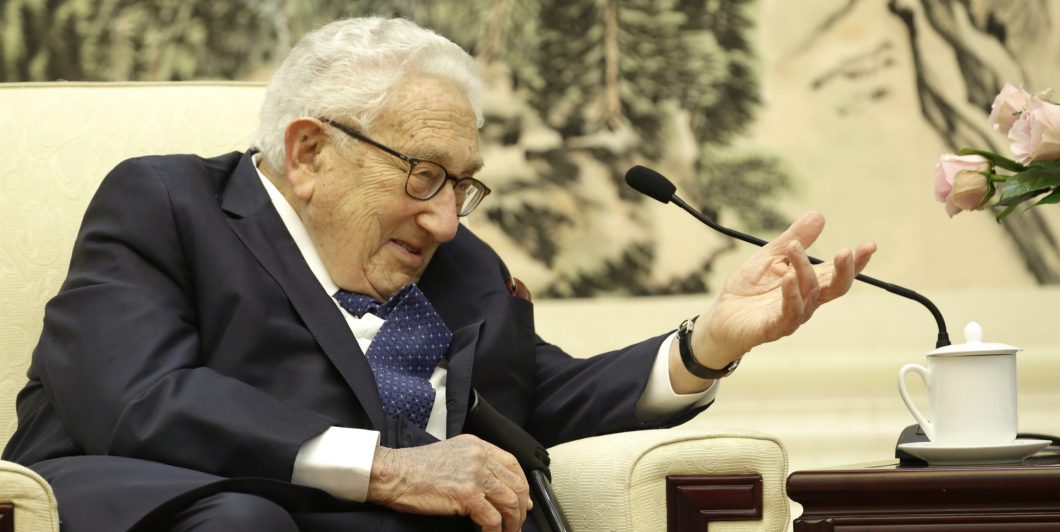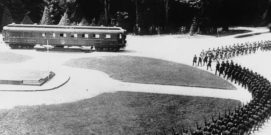What lessons remain eighty years after France's collapse in the face of the German onslaught?
Middle-Class Statecraft
Henry Kissinger believes that what sets great leaders apart is their ability to move beyond mere management—they bring a vision of what their nations might accomplish that extends beyond most people’s imaginative horizon. He argues that such transformational figures successfully balance the roles of statesman and visionary.
His recently published Leadership offers reflections on six figures who reached the pinnacle of their nation’s political life and guided their people through various crises. The book reflects his lifetime in international politics and his personal acquaintance with his subjects, as well as his belief that great leaders are not so much forged by their environments as they are self-made.
Tensions of Leadership
Statecraft is a twofold art, one that combines boldness with prudence. First, the art involves actively shaping events in a nation’s favor, “manipulating circumstances rather than being overwhelmed by them.” Second, it requires a degree of wariness, the caution to build “hedges against the possibility that even the most well-made plans might prove abortive, or that the most eloquent formulation might hide ulterior motives.” Both require a leader be grounded by a sense of their country’s history and tradition, as well as an appreciation for the role of one’s own nation-state on the world stage.
By contrast, visionary leadership is future-oriented. It “treats prevailing institutions less from the perspective of the possible than from a vision of the imperative.” He sees the work of the visionary as seeing what might be and how to achieve it in a way that transcends the pressures of the present moment. Taking this work to its logical conclusion, the visionary might be tempted to simply erase the vestiges of the past. Indeed, Kissinger suggests that many of the twentieth century’s great political tragedies flowed from the bloody dreams of powerful leaders possessed by ideological demons. Vision unbalanced by prudential statecraft makes for dangerous politics.
Although both statecraft and visionary leadership are powerful forces in the world, the combination of these gifts in a single individual is rare—far better, Kissinger suggests, for the practical arts of statecraft to be present. He believes that greatness is found in statecraft with a modicum of the visionary mode—as the visionary leader always poses the risk that “an ecstatic mood may submerge humanity in the vastness of a vision and reduce the individual to an object.”
Leadership presents the reader with six biographical sketches, composing a genuinely diverse cast of characters—Konrad Adenauer, Charles de Gaulle, Richard Nixon, Anwar Sadat, Lee Kuan Yew, and Margaret Thatcher. The sketches are colorful, well-drawn, and will lead most readers to want to know more about these figures. These are figures who exercised both vision and statecraft in striking measure, and Kissinger argues that the blend of these traits makes them something like the fulcrum on which events turn.
Kissinger uses their stories to show the ways that their influences alone aren’t enough to explain their personality and achievement. Something is sui generis about each of these people. Each of them was marked by a kind of clear insight and strong ability to filter out the unimportant. Since Kissinger cannot explore all that made these figures worthy of study, he focuses his chapters on themes that he takes to be central to each of his subjects.
Seeing the crucial need to rebuild Germany as a trusted partner, Adenauer developed a “strategy of humility,” and sought reconciliation with the allies, and in particular, France. De Gaulle practiced a strategy centered around grandeur and mystery. Kissinger views Nixon as a man undone by the unlimited desire for approbation, but nonetheless a clear-sighted leader marked by keen reflective ability and decisive action. Sadat presents a somewhat different figure whose achievements were “mainly conceptual in nature,” but whose devotion to strategic independence and national sovereignty dramatically changed Egypt’s position in the international system. Lee embraced a vision of Singapore’s future devoted to excellence and built the city-state into the economic powerhouse we see today. Finally, Thatcher drew her statecraft from a deep set of philosophical convictions and study, allying deft political maneuvering with principle in a particularly effective manner.
All of these are decidedly middle-class figures, and this leads Kissinger to one of his central observations: although they came of age in a world still formed by lingering aristocratic assumptions, they rose to power through the doors opened by rising middle-class meritocracy. Kissinger argues that this transformation also revolutionized the international system in the twentieth century; the book connects these individuals to the broader phenomenon they worked within.
Studies in Extremes
Kissinger’s portrait of de Gaulle offers one of the more striking examples of this analytical framework: de Gaulle stressed the visionary side of leadership without succumbing to delusions of grandeur or losing sight of statesmanlike prudence. He shows how de Gaulle’s work resembled that of an “illusionist,” casting his “certain idea of France” far ahead of French reality to show his people what might be. He was a legendarily difficult man, but for Kissinger, this proved to be less an obstacle to France’s survival and ultimate restoration than the crucial groundwork for it: “his impulse, consistent and in many ways heroic, to defend France’s historical identity in the face of great disparities of power became the prerequisite to restoring French greatness.” His account suggests that de Gaulle united the best of the aristocratic world order with the new liberal one dominated by merit. Kissinger suggests that France’s lingering aristocratic sensibilities denied de Gaulle a great role until the nation fell to the Nazis—and his “extraordinary prescience” could only be rewarded fully in a regime more compatible with merit.
De Gaulle also allows Kissinger ample space to suggest another major theme of the book—that greatness is highly unpredictable, and impossible to reduce entirely to theory or history. In a brief, illuminating section of the book comparing Churchill and de Gaulle, Kissinger writes, “Churchill’s leadership was an extraordinary emanation of a tradition, fitting to its circumstances; his personal style was ebullient and leavened by delightful humour. De Gaulle’s leadership was not an elaboration of a historical process but a unique expression of a personality and of a special set of principles.” In simply recounting the latter’s extraordinary accomplishments as a tempered visionary, one wonders how it was such a man came to be—and how he could so inspire ordinary people to believe in the extraordinary.
Kissinger’s chapter on Nixon carries an unavoidable sense of lost opportunity. He presents Nixon as a tremendous exemplar of both prudence and vision. Nixon’s statecraft was quite grounded in American political reality, but he nonetheless saw dramatic possibilities for reconfiguring the international system to American advantage. At the same time, Nixon was keenly aware of the strange limits our politics places on our foreign policy. Kissinger suggests that Nixon’s achievement had a great deal to do with the ways he overcame some of the factors that make American foreign policy so erratic and disastrous. Nixon undertook these efforts in a period of high tension between the Soviet Union and United States, and he had to overcome two challenges in order to negotiate a change in the world order.
American attitudes toward diplomacy in general and negotiations in particular tend to fall into two extremes: what Kissinger calls the “psychiatric” and “theological”:
The former holds that negotiations are ends in themselves, so that, once state adversaries meet face to face, their dispute may be dealt with as a manageable and potentially resolvable misunderstanding, almost similar to personal quarrels. The theological approach conceives of adversaries as infidels or apostates and treats the very fact of negotiations with them as a kind of sin.
Nixon viewed international negotiations as one more tool in a larger strategy. He was helpfully “never tempted by the conceit that establishing personal rapport with foreign leaders could transcend conflicting national interests”—a tendency that unfortunately dovetails with the “psychiatric” approach so many American politicians bring to their work. A foreign policy rooted in national interest, Kissinger argues, helps remind us that other nations have their interests, too. This approach served American foreign policy well, on Kissinger’s account, because it helped to create the space for a dramatic shift in the conduct of the Cold War. He suggests that many later critics would dramatically oversell the degree to which Reaganite ideological certainties unraveled the Soviet sphere—a set of convictions that were “understood as a vindication of America’s confident verities about the world,” and have led us into avoidable disasters in the decades since:
Among them is the belief that adversaries will collapse due to their own dynamics or can be crushed; that friction between countries is more often the result of either misunderstanding or malevolence rather than of differing interests or values that each side regards as valid; and that, with only a push from the United States, a rules-based order will naturally develop as the expression of inexorable human progress.
While he declines to name the worst offenders, it is not hard to see the ways that realism of this sort runs against a default disposition still found in both of America’s major political parties. It also serves a strong reminder of how Kissinger’s realism—unlike that of many academic realists—tends toward a kind of conservatism. His politics is one that embraces a measured view of what political persuasion can accomplish, a skepticism toward History as an engine of Progress, and a grim acceptance of conflict as inevitable because of human nature—and so too, national interests.
Kissinger and World Order
The book’s biggest surprise comes in the way that Kissinger treats his subjects’ intellectual and moral views. While he does not render extended judgment on them, he assigns significant weight to these commitments as a causal factor in shaping their statecraft. Perhaps even more surprising, he observes that nearly all of his subjects were driven by deep religious faith, and suggests that these beliefs “helped to instill self-mastery and a preference for taking the long view.” He does not attempt to sugarcoat the degree to which leadership requires not just a “penetrating sense of reality” but also the ability to make hard, life-and-death choices where all the outcomes may have evil consequences. This moral emphasis leads Kissinger to recognize that some of the most glaring failures in leadership around the globe have been manifested in ways that he might not have predicted thirty years ago.
Kissinger laments the failings of today’s faltering meritocracy:
The civic patriotism that once lent prestige to public service appears to have been outflanked by an identity-based factionalism and a competing cosmopolitanism. In America, a growing number of college graduates aspire to become globe-trotting corporate executives or professional activists; significantly fewer envision a role as regional- or national-level leaders in politics or the civil service. Something is amiss when the relationship between the leadership class and much of the public is defined by mutual hostility and suspicion.
Kissinger here recognizes that interest cannot bind a people together. Ideology might bind peoples in common derangement, he suggests. But the “civic patriotism” he references is rooted in a people’s common moral life, shared culture, and even their religious faith. This is not to say that at age ninety-nine, Kissinger has become a public moralist. But this account recognizes that America—and much of the West—has lost something as they have encouraged their best and brightest to adopt the more cosmopolitan mores exemplified by the academy and elite business class. This is not the only cause of our crisis of leadership, however.
Our obvious lack of great leadership flows from the decline of deep literacy and thoughtfulness. Here, Kissinger argues that the rise of visual and digital culture is responsible. Television and social media produce less thoughtful and attentive minds, and television in particular, Kissinger thinks, undermined older norms of self-command and restraint in favor of public emotionalism and impatience. That this shift has happened amidst a world experiencing dramatic technological change is a disaster, he argues.
But despite a kind of gloomy realism about the challenges confronting our world, Kissinger’s overarching argument nonetheless demands an attitude of hope. Just as previous great leaders were to some degree sui generis, the next great statesmen could emerge from the most unlikely of places.
The unstated question lurking in Leadership is whether we will be worthy of them.



